Investing
Vietnam’s 2025 GDP to grow 6.5% on robust infrastructure investment, consumer spending recovery: VinaCapital
Published
10 months agoon
Domestic factors, including a ramp-up in Government infrastructure spending, a revival of the real estate market, and a recovery of consumer spending, will help sustain Vietnam’s GDP growth at a circa 6.5% pace next year, in-line with the National Assembly’s official target and with 2024 GDP growth, write Michael Kokalari, chief economist at VinaCapital.

Michael Kokalari, chief economist at VinaCapital. Photo courtesy of the company.
The strong US economy supported Vietnam’s GDP growth in 2024, but domestic factors will drive the economy in 2025 because Vietnam’s economic prosperity is closely linked to the U.S. and export growth to the U.S. is set to slow next year for a variety of reasons.
Vietnam’s Government is planning policy measures that should mitigate the impact of that slowdown, but drastic measures will be needed to achieve the Government’s increasingly ambitious 2025 GDP growth targets (some officials have mentioned figures as high as 8%).
These three key points will help investors better understand Vietnam’s economy and stock market in 2025:
Domestic factors will determine 2025 GDP growth.
Vietnam’s exports to the US surged this year, as did foreign tourist arrivals, but the growth of both is set to slow dramatically next year. Many analysts underestimate how much slower export growth will weigh on Vietnam’s 2025 GDP growth, but Government initiatives and improving consumer sentiment could help sustain 6.5-7% growth next year.
The government is in the Driver’s seat.
Government officials recently announced multiple measures to boost Vietnam’s economy, including increased infrastructure spending and serious structural reforms. These measures will certainly boost long-term GDP growth but may not be sufficient to offset slower export growth next year – which means more drastic measures may be required to meet growth targets.
Vietnam’s “Trump risk” is overstated.
Vietnam and Mexico were the biggest winners during Trump’s first administration. We see minimal risk that Trump’s tariff policies will derail Vietnam’s growing economy – in sharp contrast to claims published in some newspaper articles since his election – but Vietnam has the third-largest trade surplus with the US. Vietnam will need to take urgent steps to reduce the country’s trade surplus with the US to avoid being targeted by Trump at some point.
Next, the VN-Index is up 12.1% year-to-date (as of 18 December 2024), despite record selling by foreign investors, which was partly prompted by a near 5% year-to-date depreciation in the Vietnamese dong. The resilience of Vietnam’s stock market despite nearly $4 billion of net foreign selling, coupled with a very attractive valuation (12x forward P/E versus ~17% expected EPS growth) means that the VN-Index would not need much of a catalyst to continue climbing next year. However, 2025 could be a “roller coaster year” for both the stock market and economy.
Concerns related to Trump’s tariffs, combined with slower export and GDP growth, could weigh on the VN-Index, and on the value of the Vietnamese dong in the first half of 2025. In the second half of the year, Vietnam’s GDP growth should accelerate if-and-when the Government takes aggressive actions to support the economy, and USD-VND depreciation pressures should ease along with concerns about Trump’s impact on Vietnam.
Vietnam is the third closest linked to the U.S. and has the third biggest trade surplus with the U.S.
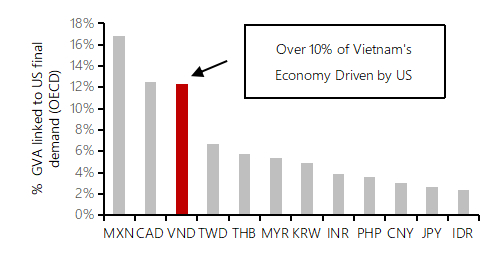
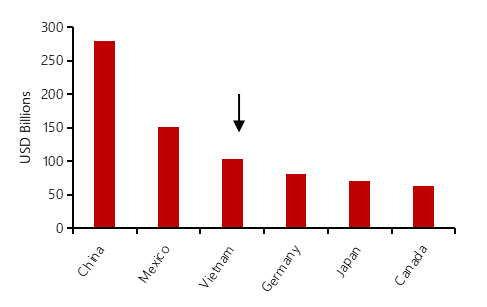
Domestic factors will drive Vietnam’s economy In 2025
Vietnam’s economy is closely linked to the U.S. Exports to the U.S. surged by well over 20% this year (versus a circa 10% drop in 2023), which is the main factor supporting Vietnam’s 2024 GDP growth. That surge was in-turn driven by a 40% jump in exports of electronics and other high-tech products to the U.S. However, we expect the extraordinary increase in exports to the U.S. to moderate next year partly because the U.S. economy is likely headed for a “soft landing” economic slowdown.
Additional reasons to expect slower export growth next year are related to the U.S. inventory re-stocking cycle that we discussed in our Looking Ahead at 2024 report (in which we made the non-consensus call that Vietnam’s manufacturing output and exports to the U.S. would surge this year).
Furthermore, exports across Asia are currently being boosted by “pull-forward” demand in the lead-up to Trump taking office – that will lead to lower demand next year. Consequently, Vietnam’s manufacturing output growth will likely drop next year, since most products produced here are sold to overseas customers.
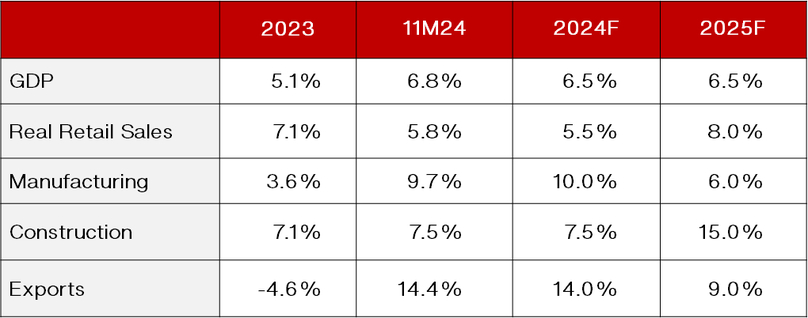
That said, we do not expect Vietnam’s exports and/or manufacturing output to actually shrink next year because a steady inflow of FDI ensures that more factories begin producing (and exporting) products in Vietnam every year.
Also, despite the expected slowdown in manufacturing output growth next year, we expect Vietnam to achieve 6.5% GDP growth in 2025 because we expect the composition of the growth to transition to more domestically driven factors next year, as can be seen in the table above.
Weak sentiment among Vietnamese consumers weighed on the country’s economic growth in 2023 and 2024, although it has improved somewhat as this year progressed, according to local consumer research firms such as Cimigo and InFocus Mekong Research.
Real retail sales growth (i.e., stripping out the impact of inflation) is about 6% this year, which lags below the 8-9% growth rate that is typical in Vietnam. Furthermore, about half of that 6% figure is attributable to the continued recovery of foreign tourist arrivals from 70% of pre-Covid levels in 2023 to 100% in 2024.
Consumption accounts for over 60% of Vietnam’s economy (vs ~25% for manufacturing), so healthier consumption growth would easily compensate for slower growth in exports/manufacturing/tourist arrivals next year.
Vietnam’s Government has indicated that it will increase infrastructure spending in 2025, and hopes are high that this and other measures will also make consumers more confident to increase their spending. We anticipate a pickup in consumer spending next year for a different reason: we expect Vietnam’s Government to take significant steps to unfreeze the real estate market.
We believe that a recovering real estate market would have a far greater impact on both consumer sentiment than increased infrastructure spending. A modest increase in infrastructure spending, which accounts for ~6%/GDP, in-and-of itself would not be sufficient to significantly boost Vietnam’s economy.
However, the combination of faster progress on projects like HCMC’s new airport and Hanoi’s new ring roads, coupled with a real estate market revival, would probably make consumers feel more confident to spend money because of the “wealth effect” linked to the value of the property that many (most?) middle-income Vietnamese consumers own.

We mapped out our expectations for 2025 GDP growth in the diagram above: 1) if the Government does nothing to offset slower exports to the U.S. next year, 2) if the Government only boosts infrastructure spending in response to slowing demand for “Made in Vietnam” products (which we do not believe would be sufficient to improve consumer confidence), and 3) if the Government were to both boost the real estate market and infrastructure spending, which we believe would make local consumers sufficiently confident to spend money.
Further to that last point, Government officials announced increasingly aggressive GDP growth targets in recent weeks. We are reassured by their ambitious goals because of our view that decisive actions will be needed to offset the impact of an expected drop in export growth to the US next year.
However, initiatives such as extending Vietnam’s VAT tax cut from 10% to 8% for another six months or plans to streamline the Government’s operations (see below) are either too modest to have any real impact on 2025 growth or will eventually become powerful drivers that boost Vietnam’s long-term growth potential but will not boost GDP growth in 2025.
Finally, it is possible that 2025 will be somewhat volatile for Vietnam’s economy and stock market. In the first half of 2025, falling export growth will likely deal a bigger blow to Vietnam’s GDP growth than many economists expect. That dip would probably prompt aggressive Government actions to support the economy, especially in light of the very ambitious GDP growth targets.
The net result could be subdued growth at the beginning of 2025, followed by a strong acceleration towards the end of 2025. All of that said, “It’s tough to make predictions, especially about the future,” as famed American baseball player Yogi Berra once said.
The Government is in the driver’s seat for 2025
Vietnam’s national assembly set a 2025 GDP growth target of 6.5-7% on November 12, after which various senior Government officials announced even more ambitious growth goals and vowed that the Government will take aggressive actions to ensure that Vietnam achieves those ambitious goals. As stated above, we believe concrete measures will be required to offset the expected drags on 2025 GDP growth.
We expect manufacturing growth to drop from 10% this year to 6% next year, which would knock about 1% pt off Vietnam’s GDP growth (manufacturing is ~25%/GDP growth) and we expect the growth of foreign tourist arrivals to fall from 40% this year to 15% next year, which will knock more than 1.5% pts off GDP growth (foreign tourism is ~8%/GDP). Various Government officials have guided to expect a ramp-up of infrastructure spending to support 2025 GDP growth and strengthen the country’s long-term growth prospects.
Based on communications from Government officials and others, it seems likely that the Government’s infrastructure spending will grow by 15-20% in 2025 to ~$31 billion (or ~6%/GDP) on projects such as completing another 1,000 km of highways, completing the first phase of HCMC’s new airport, and expanding the two current airports in HCMC and Hanoi.
However, that 15-20% growth would equate to an additional ~$5 billion of spending (or to about ~1%/GDP), which would not be sufficient to offset the hit from slower manufacturing and tourism growth outlined above, so additional measures will be required to sustain Vietnam’s rapid GDP growth next year.
Measures to boost Vietnam’s long-term GDP growth
In the short-term, it is possible that Vietnam’s Government could spend even more on infrastructure development, given its healthy finances (Government debt is below 40%/GDP), and we expect the Government to take concrete steps to support the real estate market next year; we already see some promising signs on the latter.
The slow zoning and approvals process is the biggest impediment to ramping up real estate development, but we are hearing anecdotal evidence that some project approvals are now being expedited (i.e., some projects which used to take 6-9 months to be approved are now being approved in as little as three months).
In addition to those and other modest measures to boost Vietnam’s short-term growth, the Government is taking some serious steps to boost the country’s long-term GDP growth. These measures include structural reforms, some of which will come into effect next year and could help thaw the real estate market and improve Vietnam’s ease-of-doing business rankings. Plans have also been announced to merge five Government ministries and numerous Government agencies in order to streamline the Government’s operations
We are enthused by these and other recently announced initiatives, such as plans to build a high-speed rail line that would span the length of the country. However, these measures will have no effect on GDP growth in 2025, and this report is focused on Vietnam’s economy and stock market next year.
Likewise, the Government has taken some encouraging steps to support Vietnam’s long-term economic growth by realizing the country’s high potential in semiconductors and AI. We plan to publish reports on both of these topics in the months ahead.
Vietnam’s “Trump risk” is overstated
Donald Trump’s election has spawned excess pessimism about the potential impact of his policies on Vietnam from some reporters in the international media. In reality, Vietnam is unlikely to be targeted by the U.S. because it is useful to the U.S. to achieve its own geopolitical and other goals (we discussed the potential impact of Trump on Vietnam in more detail in three reports we published since the election).

Furthermore, if Trump were to impose 5-10% blanket tariffs on all countries’ (ex-China) exports to the U.S, Vietnam would still retain its advantages in attracting FDI into the manufacturing sector. That said, Vietnam has the third-largest trade surplus with the US, which is a cause for concern.
Trump recently announced his intention to impose 25% tariffs on Canada and Mexico, plus to add an additional 10% tariffs on China’s exports to the U.S. That announcement, coupled with Vietnam’s $100 billion trade surplus with the U.S, has prompted fears that Vietnam could be targeted next, but the currency markets give strong hints of what actually comes next.
The Mexican Peso depreciated by more than 20% against the US dollar in the lead-up and immediate aftermath of the election, versus 2% year-to-date and 6% year-to-date depreciations respectively for the Chinese yuan and Canadian dollar after Trump’s recent tariff announcement.
The message of the market is clear: Mexico is the target and traders expect Canada, China, and Vietnam to negotiate deals with the Trump administration to avoid crippling tariffs on their exports to the U.S. (the USD-VND exchange rate did not move after Trump’s latest tariff announcement).
All of that said, China’s annual FDI into Vietnam essentially doubled over the last three years, making China the biggest FDI investor into Vietnam, which could attract the scrutiny of US officials at some point (although we expect newly registered FDI in Vietnam will fall next year due to uncertainties about Trump’s tariffs on Vietnam).
Why Trump likely won’t target Vietnam
Trump’s primary stated objectives (as relates to Vietnam) include re-shoring manufacturing jobs back to the US and shrinking America’s trade deficit. Regarding the latter, after the election Vietnamese Government officials announced intentions to shrink the trade surplus by buying LNG and aircraft from the U.S. (energy industry insiders told us Vietnam could quickly start importing ~$30 billion a year worth of LNG from the U.S. by using Floating Storage and Regasification Units).
Regarding re-shoring, wages in the U.S. are too high and the supply of skilled workers is too low to cost effectively produce “Made in Vietnam” products in the US. Bloomberg interviewed a U.S. manufacturing executive in a recent article on this topic who lamented “Toolmakers are a lost art. It’s going to take a long time for us to rebuild that level of skill [in the US]”.
The table below, which is a small sample of consumer products that the U.S. imports, is an indication of how much the production of products that are consumed in the U.S. has been outsourced to other countries – and how difficult it would be to re-shore the production of those products.
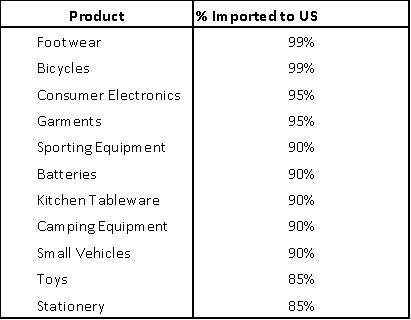
Source: FDRA, FRED U.S. Database, VinaCapital analysis.
Republicans and Democrats alike are both concerned about the transhipment of “Made in China” products to the U.S. via Mexico and/or Vietnam to skirt U.S. tariffs on Chinese products. A bipartisan group of U.S. Senators implored President Biden to “address China’s rampant exploitation of Mexico as an intermediary for the transshipment of goods” in September.
In contrast, only about 2% of Vietnam’s exports to the U.S. are transshipments of Chinese products, according to research from Harvard University, and we expect close cooperation between Vietnam Customs officials and US technical experts to address that re-routing issue.
Finally, U.S. business and consumer confidence surged after Trump was elected, which should ultimately boost U.S. demand for “Made in Vietnam” products. Consumer confidence in the U.S. experienced its biggest post-election bounce since Bill Clinton was elected. That said, it will take some time for that elation to translate into increased exports from Vietnam to the U.S., so this will probably be a story for 2026.
Another volatile year for the Vietnamese dong
The USD-VND exchange rate has been very volatile over last three years, primarily because the Fed initiated one of its rapidest-ever rate hiking cycles starting from early-2022, and then began cutting rates in September 2024, although Vietnam-specific dynamics also affected the dong.
The State Bank of Vietnam (SBV) cut interest rates in Vietnam during H1/2023 as the U.S. Fed was hiking rates, which resulted in a record-high gap between short-term VND and USD interest rates (VND rates were more than 500 bps below USD rates at that time), putting enormous depreciation pressures on the dong in H2/2023.
This year, the VND had depreciated by nearly 5% year-to-date in May, driven by a near 4% year-to-date increase in the US Dollar/DXY Index (owing to “sticky” U.S. inflation and waning Fed rate cut expectations) and driven by political concerns in Vietnam. The SBV responded to VND depreciation by tightening monetary policy and selling around $6 billion of its FX reserves, reportedly reducing the SBV’s total reserves to around $87 billion, which is less than three months’ worth of imports.

In recent months, the USD-VND exchange rate has “whipsawed” by appreciating in anticipation of the Fed’s September 2024 rate cut, but then depreciating in the anticipation of Donald Trump’s election (the DXY Index surged ~7% in the lead-up and immediate aftermath of the US presidential election because tariffs push up the value of the U.S. Dollar). We expect 2025 will see some fluctuations for the Vietnamese dong, but the USD-VND exchange rate will ultimately end next year with a manageable 3% depreciation against the US dollar.
Two Vietnam-specific factors will impact the dong in 2025: 1) Vietnam’s FX reserves are currently below three months’ worth of imports, and 2) Vietnam’s ~6%/GDP trade surplus is set to shrink. Regarding #1, central banks generally hold a minimum of three months of FX reserves (insufficient FX reserves would inhibit the SBV from selling U.S. dollars to defend the dong, for example). We mentioned above that the Vietnamese dong appreciated versus the USD in the lead-up to the Fed’s September rate cut. However, the USD-VND exchange rate appreciated by less than its Asean EM peers from July to September due to the SBV’s insufficient FX reserves.
Regarding Vietnam’s trade surplus, FDI factories depleted their inventories of production inputs over the last two years. That depletion boosted Vietnam’s trade surplus (~6%/GDP in both years) because the vast majority of those production inputs are imported and then used to produce products that are exported.
FDI firms are now importing more inputs to re-stock their inventories, so Vietnam’s import growth is now outpacing export growth (circa 16% import growth vs 14% export growth). We expect that differential to widen next year, which would shrink Vietnam’s trade surplus.
The dollar and the dong
Our prediction that the VND will depreciate 3% next year is predicated on our expectation that the U.S. Dollar/DXY Index will finish 2025 nearly unchanged (the DXY is the single biggest factor driving the USD-VND exchange rate). However, 2025 is likely to be a very volatile year for the U.S. dollar, partly because U.S. inflation was always going to rebound in early 2025 for a variety of reasons, irrespective of who won the presidential election. The market is pricing in two more Fed rate cuts next year, but we would not be surprised if the Fed does not cut rates at all next year, which would push the USD higher.
Furthermore, about two-thirds of the tariffs that the U.S. imposes on other countries ultimately get reflected in a higher value of the US dollar. That implies the U.S. dollar will continue to appreciate if Trump follows through with his plans to impose tariffs on Canada/Mexico/China, but incoming Treasury Secretary Scott Bessent and others also guided that the Trump administration intends to use tariffs as a negotiation tool to push down the value of the U.S. dollar via a so-called “Plaza Accord 2.0” international agreement.
The Vietnamese dong, Chinese yuan and VN-Index
Many analysts mistakenly believe that a significant depreciation in the USD-CNY exchange rate would be very negative for Vietnam’s economy and would put significant depreciation pressure on the VND. However, a 10-25% depreciation of the CNY against the VND would not derail Vietnam’s export competitiveness because factory wages in Vietnam are less than half those in China.
It would however lower Vietnamese production costs because Vietnam imports over a third of its production inputs from China. That said, movements in the CNY have a major sentiment impact on both the USD-VND exchange rate and on the VN-Index.
Finally, movements in the USD also have a major impact on investor sentiment towards the VN-Index, but unlike fluctuations in China’s currency, the link between the USD-VND exchange rate and the VN-Index is rooted in economic logic. The SBV typically tightens monetary policy whenever the VND depreciates by more than 3% year-to-date, which reduces local liquidity available to buy stocks. Also, VND depreciation tends to trigger foreign outflows from the stock market, as it has this year – which is discussed in the next section of this report.
The Stock market in 2025
The VN-Index (VNI) is up 12.1% year-to-date in VND terms as of December 18, 2024. The index surged at the beginning of the year, driven by record-low deposit rates (following four rate cuts last year), driven by recovering corporate earnings, and supported by attractive valuations.
However, VND depreciation and other factors prompted foreigners to sell $3.6 billion of Vietnamese stocks this year (following $940 million of outflows last year) depressing foreign ownership of Vietnam equities to a record-low of below 17%.

We expect foreign money to return to Vietnam’s stock market next year once it becomes apparent that Trump is not going to target Vietnam, driven in part by an acceleration in earnings growth of listed companies from 13% in 2024 to 17% in 2025. Furthermore, the market’s valuation remains attractive at a 12x forward P/E, which is 1 standard deviation below the VN-Index’s 10-year average and 20% below the valuation of Vietnam’s regional peers Malaysia, Thailand, Indonesia, and the Philippines.
Valuation is also attractive on a PEG ratio basis at ~0.7x as well as when comparing the “earnings yield” of the VN-Index (i.e., the inverse of the VN-Index’s 12x P/E ratio) to the 12-month deposit rates that banks pay (note that we have made an adjustment to the so-called “Fed model” that Warren Buffet and others follow closely in order to make it work for Vietnam’s stock market by replacing 10-year government bond yields with bank deposit rates).
VN-Index 12M P/E Forward (x) VN-Index’s earnings yield vs. 12M deposit rates

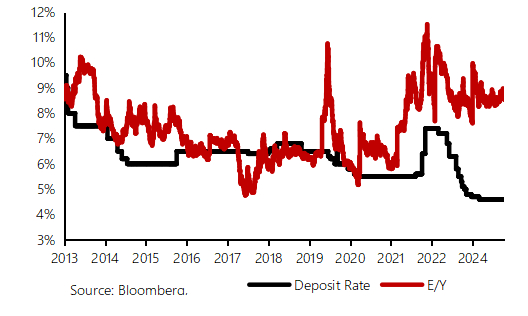
Next, the earnings growth acceleration we expect in 2025 is partly predicated on our expectation for a recovery in the residential real estate sector next year (from 9% “core” earnings growth in 2024 to 20% in 2025), which in-turn should also help support a pick-up in banks’ earnings – because mortgage lending should accelerate along with real estate development activity. The banking sector’s heavy weight in the VN-Index means that even a modest pick-up in earnings growth (from 14% in 2024 to 17% in 2025) meaningfully boosts the total earnings growth of the VN-Index.
The chart below summarizes our “core” earnings growth expectations by sector (ie. stripping out extraordinary items). The wide variations in sector performance below give ample opportunities to active investors to beat the market with savvy stock selection.
Sector weight (%) core earnings growth in 2025 by sector
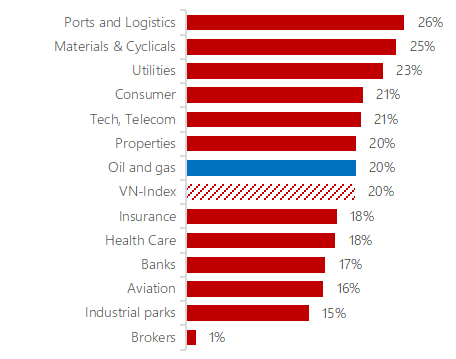
Next, investor sentiment is currently being boosted by growing expectations that Vietnam will be upgraded from a Frontier to an Emerging Market by FTSE in 2026, as Vietnam now meets nearly all of FTSE’s criteria to be considered an EM market- following recent administrative reforms that bring the stock market’s functioning closer in-line with international standards. Sentiment is also being supported by optimism about Government announcements of planned measures to boost Vietnam’s GDP growth in 2025 and beyond as discussed above.
With respect to the potential “Trump Risk” mentioned earlier in this report, although we do not think there is a risk that Trump will derail Vietnam’s economic growth, he could have a major impact on stock market sentiment in Vietnam and the rest of Asia.
We are particularly concerned about proposed U.S. legislation to revoke China’s Permanent Normal Trade Relations (PNTR) status, which would be a major escalation in the U.S.-China trade war that would rattle Asian markets. Also, it is likely that the value of the U.S. dollar will initially surge in early-2025, which would depress Asian stock markets, but then fall back later in the year for reasons discussed above.
Stock and sector selection drives performance
Outperforming the VN-Index entails savvy stock selection. Our preferred sectors to own in 2025 include: real estate, banks, consumer goods, materials, and IT.
Residential real estate
Pre-sales of new housing units are up around 40% in 2024, which should translate to 20% sector-wide earnings growth next year. The demand for new housing products in Vietnam outstrips supply by a factor of 2:1 and we are hopeful that recent legal reforms will expedite project approvals going forward – which would in-turn drive developers’ earnings for years to come.
In the short term, demand for mid-tier products (circa $1,500-2,000 /sqm) is especially strong, and there is considerable anecdotal evidence of a likely, continued surge in real estate development (many architects in Vietnam are the busiest they have been for years).
Banks
We expect sector-wide earnings growth to pick-up from 14% in 2024 to 17% in 2025, driven by lower credit costs. Deposit rates are likely to increase 50-100 bps next year because loan growth is outpacing deposit growth this year – prompting banks to scramble to raise deposits.
However, we expect stable NIM’s next year because lending is increasingly being driven by high-margin mortgages, and infrastructure loans. Sector-wide valuation remains very cheap at 1.3x Forward P/B versus 17% expected ROE, which is nearly 2 standard deviations below the five-year, sector-wide mean P/B.
Consumer goods
Consumer sentiment in Vietnam has been picking up as 2024 progress and we expect a full recovery to 8-9% real retail sales growth next year (in-line with Vietnam’s long-term average growth), which should boost revenues of consumer facing firms. We also expect sales of discretionary products such as smartphones and laptops to outpace overall retail sales next year; consumers typically replace such products after 3-4 years, and the previous sales peak was in 2021 during Covid.
Materials and cyclicals
We expect steel consumption in Vietnam to grow 10% in 2025, driven by the nascent recovery of real estate construction and by an expected 15-20% increase in public infrastructure construction next year, which help drive 25% sector-wide earnings grow in 2025.
Information technology
We expect the earnings growth of FPT, which dominates Vietnam’s IT sector, to remain at around 20% in 2025, driven by the ~30% growth in its software outsourcing revenue. FPT benefits from the continued robust growth in global IT spending and is well positioned to capture rising demand for AI-related services particularly given the company’s close relationship with Nvidia.
Finally, the long-term growth prospects of the logistics and industrial park sectors also remain very attractive. Vietnam’s ongoing industrialization will almost certainly continue for years to come, driving demand in both sectors. Vietnam’s rapidly growing middle class will also continue driving the rapid growth of ecommerce in Vietnam, which in turn will drive demand for “last mile” services and cold-chain logistics in Vietnam.
Conclusions
The surge in Vietnam’s exports to the U.S. that supported Vietnam’s GDP growth this year is likely to moderate next year, but we expect domestic factors, including a ramp-up in Government infrastructure spending, a revival of the real estate market, and a recovery of consumer spending, to help sustain GDP growth at a circa 6.5% pace next year, in-line with the National Assembly’s official target and with 2024 GDP growth.
You may like
-


Vietnam’s Exclusive Economic Zone boasts over 1,000 GW of wind power potential: report
-
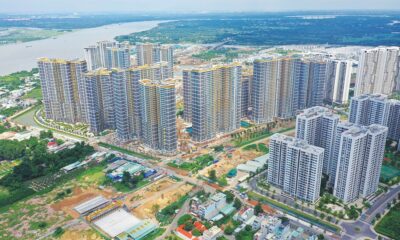

Uncertainty weighing on real estate
-


Central Vietnam city seeks $1.84 bln for 15 projects in economic zone
-


Green engagement rides high in Vietnam
-
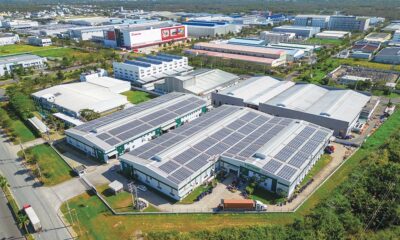

New standards being reached within green industrial parks
-
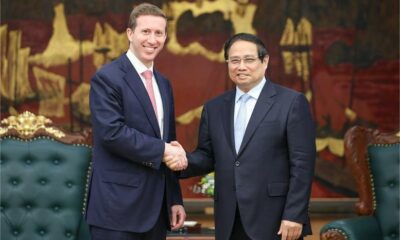

Vietnam PM asks Warburg Pincus to invest ‘further and faster’
Investing
Bac Giang International Logistics Centre launched
Published
8 months agoon
April 27, 2025Bac Giang International Logistics Centre was launched on April 22 with an investment of $168 million, and is expected to become a crucial link in the global supply chain.
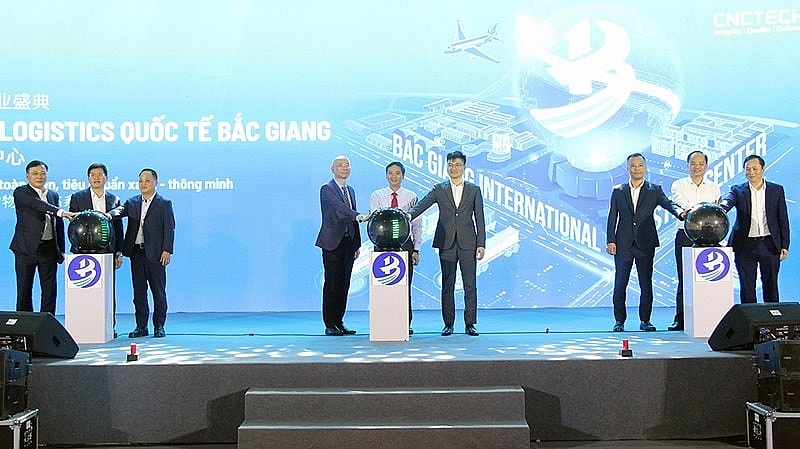 |
| Bac Giang International Logistics Centre launch |
Being invested by CNCTech Group, Dolphin Sea Air Services Corporation and Thien An Investment JSC, the logistics centre is located on National Highway 1A, which boasts first-class warehouse supply to meet the growing demand in the northern Vietnamese market.
Its strategic position within the golden economic triangle of Hanoi – Haiphong – Quang Ninh provides convenient connectivity to industrial zones and key logistics centres via national highways No.1A and No.37.
The centre is designed to meet growing demand for logistics infrastructure from businesses in Bac Giang and neighbouring provinces, positioning the area as a new node in northern Vietnam’s logistics network.
The project is a strategic product as a key component of the logistics spearhead in CNCTech Group’s industrial and logistics infrastructure ecosystem. It has been approved by the prime minister as a national level-II logistics centre, covering a planned area of 67 hectares.
At the launch ceremony, Chairman of Bac Giang People’s Committee Nguyen Viet Oanh said, “In recent years, the province’s socioeconomic development has made remarkable strides. Transportation, urban, industrial, and social infrastructure have been synchronously invested in and have yielded high efficiency. However, the province’s logistics service sector has not yet matched its potential, advantages, and socioeconomic development level. The logistics system remains fragmented, transportation costs are high, and trade delivery times are prolonged.”
Recognising this bottleneck, the local authorities have focused on directing the robust development of the logistics system, incorporating it into the provincial plan. This includes developing eight comprehensive logistics centres covering nearly 500ha, three inland container depots, and 33 inland waterway ports.
“Bac Giang, with its strategic location between Hanoi and border provinces, has long been known as a dynamic industrial hub. The remarkable development of the province’s industrial parks has created a solid foundation for the establishment of Bac Giang International Logistics Centre. This centre is not only located on vital transportation routes such as Hanoi-Lang Son Expressway but also directly connects to major border gates, optimising the transport of goods from Bac Giang to the world,” said Oanh.
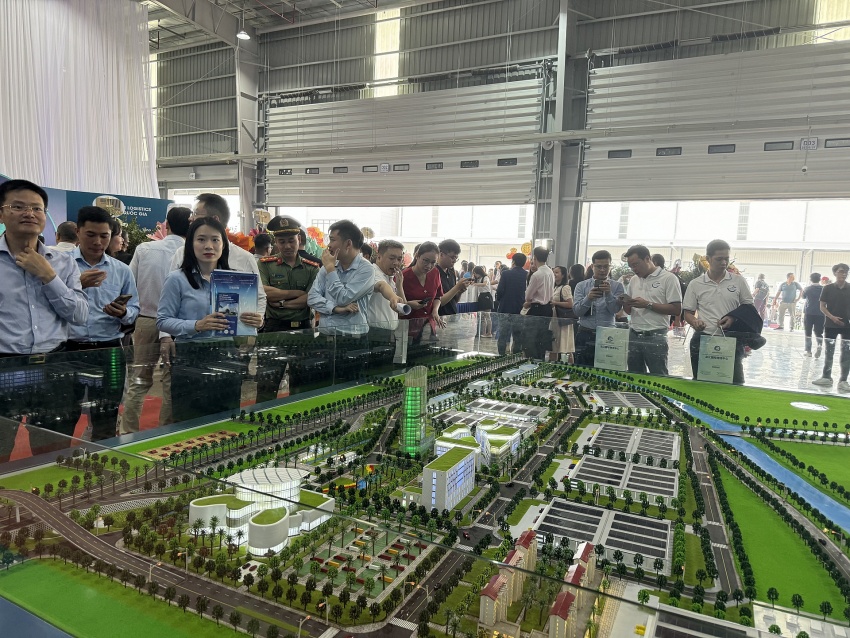 |
| A model of the logistics centre |
The project is not merely a warehousing facility, but also a symbol of the integration of modern infrastructure and advanced technology. The centre includes multifunctional warehouse areas, customs-controlled warehouses, non-tariff warehouses, and automated warehouses, meeting the needs of various industries. Notably, it integrates end-to-end logistics solutions, supporting businesses in optimising transportation costs and enhancing production efficiency.
With a long-term vision, the centre aims not only to optimise domestic supply chains but also to become a key connection point in the global logistics network.
Nguyen Van Hung, chairman of the Board of Members of CNC Tech Group, shared, “The establishment of this centre is a strategic step in developing Vietnam’s logistics infrastructure. We are committed to long-term and robust investment in this sector, as logistics is not just infrastructure but an indispensable part of enhancing the competitiveness of Vietnamese businesses on the international stage.”
Vietnam has taken strong action to promote green development among businesses, amid the country facing challenges in finance and technology.
Vietnamese Party General Secretary To Lam told the fourth Summit of the Partnering for Green Growth and the Global Goals 2030 (P4G), organised last week in Hanoi, that Vietnam is focused on strategic breakthroughs to prepare for a national development process that is fast, inclusive, and sustainable.
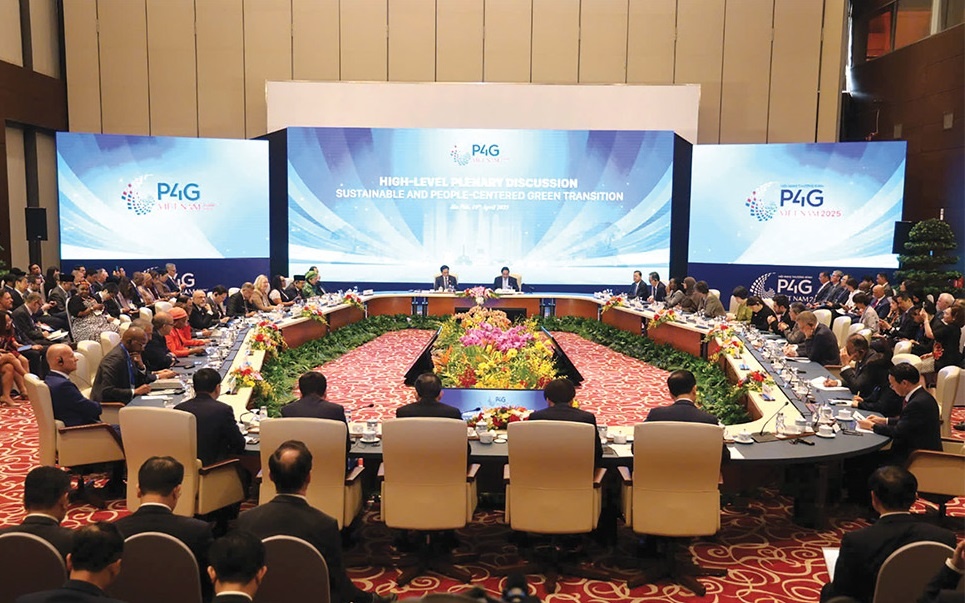 |
| The summit in Hanoi covered areas from finance and banking to agriculture and technology Photo: Dung Minh |
“We will strongly transform political commitments into practical actions, creating motivation for businesses and the whole society to participate in sustainable economic development, in which green institutions are the decisive foundation,” General Secretary Lam stressed at a hall attended by government leaders, UN representatives, diplomats, experts, and entrepreneurs.
General Secretary Lam also stressed that when it comes to green transformation, despite being a developing country with a transitional economy and limited resources, Vietnam has achieved some important results.
Besides making a 2050 net-zero commitment in 2021, Vietnam also endorsed six global initiatives at the time, on forest and land use, methane, clean power transition, sustainable food and agriculture, and more.
“Vietnam is now a leading country in supplying renewable energy in ASEAN, with wind and solar power capacity accounting for two-thirds of ASEAN’s total capacity,” he said.
“Additionally, Vietnam is also a good example of encouraging sustainable agriculture. The initiative to develop one million hectares of high-quality and low-emission specialised rice is a pioneering model that many partners and international organisations are interested in.”
A greener future
Vietnam is an active and responsible member of all multilateral mechanisms and major initiatives on green growth and energy transition such as the Paris Agreement on climate change, the Just Energy Transition Partnership, and the P4G.
“However, as a developing country with a transitional economy, we also face many challenges in terms of financial resources, technology, personnel, and resilience to the impacts of climate change and geopolitical fluctuations globally,” said General Secretary Lam.
The summit adopted the Hanoi Declaration, strongly affirming commitments to sustainable growth with people at the centre, and a determination to collaborate responsibly in addressing current global challenges. Vietnam is expected to enjoy continued support from the international community in its journey to a green economy including energy transition.
According to the World Bank, to ensure sufficient funding for responding to climate change, mobilising domestic finance is possible, but external support is needed.
Overall, Vietnam’s total incremental financing needs for the resilient and decarbonising pathways could reach $368 billion over 2022–2040, or approximately 6.8 per cent of GDP per year.
The resilient pathway alone will account for about two-thirds of this amount, as substantial financing will be required to protect the country’s assets and infrastructure as well as vulnerable people.
The cost of the decarbonising pathway will mainly arise from the energy sector – investments in renewables and managing the transition away from coal might cost around $64 billion between 2022 and 2040. All the figures are in net present value terms at a discount rate of 6 per cent.
This $368 billion in financing needs will include $184 billion from private investments or about 3.4 per cent of GDP annually, $130 billion or about 2.4 per cent of GDP annually from the state budget; and $54 billion or about 1 per cent of GDP per year from external sources.
Choi Youngsam, South Korean Ambassador to Vietnam, said that within the P4G framework, South Korea and Vietnam have completed or are currently implementing joint projects in areas such as food and agriculture, energy, water, and urban development.
“Looking ahead, both sides are expected to broaden and deepen their partnership under the P4G framework,” he said.
At the P4G Summit held in Seoul in May 2021, the two governments signed the Framework Agreement on Cooperation in Response to Climate Change, laying a solid policy foundation for the implementation of international emissions reduction ventures.
“On this basis, I hope that South Korea will leverage its technological expertise and financial resources to carry out greenhouse gas emission reduction projects in Vietnam, with both countries mutually recognising the results,” Ambassador Youngsam said.
“This would contribute to establishing a win-win model of emissions reduction cooperation. At the same time, I look forward to seeing active engagement from South Korean enterprises possessing green technologies, in close collaboration with the Vietnamese government.”
Encouraging developments
Deputy Minister of Science and Technology Hoang Minh said at a policy dialogue on the sidelines of the P4G 2025 that the active participation and strong cooperation from stakeholders – from the public and private sectors to international organisations – can help materialise Vietnam’s aspiration of an efficient and sustainable innovative startup ecosystem.
“Innovation, creative entrepreneurship and collaboration are key to solving environmental problems, while encouraging the development of a circular economy,” he said.
Vietnam currently has over 4,000 innovative startups, including two unicorns valued at over $1 billion, 11 companies valued at over $100 million, more than 1,400 startup support organisations, 202 co-working spaces, 208 investment funds, and 35 business promotion organisations. Among these, it is estimated that around 200–300 companies focus on green transition, covering areas such as renewable energy, environmental technology, sustainable agriculture, and the circular economy.
According to the Vietnamese Ministry of Foreign Affairs, hosting the fourth P4G Conference is of great significance to Vietnam. It is aimed to boost its role as a good friend, a reliable partner, and a responsible member of P4G and the international community. Moreover, it is also aimed to reaffirm its commitment to sustainable development, energy transition, and the goal of carbon neutrality by 2050. Besides that, it is aimed at contributing to raising awareness of international cooperation and encouraging the role and voice of developing countries in the sector of green growth and sustainable development.
| Pham Minh Chinh, Prime Minister
For Vietnam, together with digital transformation, we identify green transition as an objective necessity, a key factor, and a breakthrough driving force to promote rapid growth and sustainable development. This aligns with the strategic goal of becoming a developing country with modern industry and upper-middle income by 2030, and a developed, high-income country by 2045, while also contributing to the gradual realisation of Vietnam’s commitment at COP26 to achieve net-zero emissions by 2050. From practical experience with initial positive results, especially in renewable energy, green agricultural development, and participation in multilateral mechanisms and initiatives on green transformation, as the host of the fourth P4G Summit, Vietnam has three suggestions for discussions which pave the way for further cooperation in the coming time. First is to perfect green mindset, with a focus placed on the development of science and technology, innovation, and digital transformation linked to green growth. This includes recognising that green resources stem from green thinking, green growth is driven by green transition, and green resources arises from the green awareness of people and businesses in nations and regions throughout the world. Second is to build a responsible green community, in which, the government plays a guiding role, encouraging, and ensuring a stable and favourable institutional environment for green growth. The private sector functions as a core investor into technological development and the dissemination of green standards. The scientific community take the lead in developing green technologies and training green human resources. Meanwhile, citizens continuously enhance their green awareness, truly becoming beneficiaries of the outcomes of green transformation. Thirdly, it is necessary to promote international cooperation and robust multilateral green cooperation models, particularly public-private partnerships, South-South cooperation, North-South cooperation, and multilateral cooperation frameworks. This is aimed at removing institutional barriers, enhancing access, and speeding up the flow of green capital, green technology, and green governance. Developed countries should take the lead in fulfilling commitments to provide financial, technological, and institutional reform support. Meanwhile, developing countries would need to leverage their internal strengths and effectively utilise external resources. |
Investing
Public-private partnerships a lever for greener innovation
Published
8 months agoon
April 26, 2025Public-private partnerships are no longer a supporting mechanism, but a strategic pillar in the global pursuit of the green transition.
The high-level dialogue between government leaders and businesses at the 2025 P4G Vietnam Summit last week, chaired by Prime Minister Pham Minh Chinh, brought together senior officials, global experts, international organisations, and private sector leaders.
They recognised that the climate crisis, digital transformation, and resource depletion are converging in ways that demand not only innovation, but deep and long-term collaboration between the public and private sectors.
UN Deputy Secretary-General Amina J. Mohammed acknowledged Vietnam’s leadership in renewable energy, noting its potential to attract trillions in sustainable investment.
“Emerging economies must accelerate the adoption of new investment models, particularly those that align private capital with green infrastructure priorities. Governments must work with the private sector to expand ambition, strengthen accountability, and deliver real impact,” she said.
From Italy, Prime Minister’s Climate Envoy Francesco Corvaro stressed that public-private partnerships (PPPs) are indispensable in addressing climate finance gaps. Drawing from Italy’s experience, he underscored the importance of public investment as a risk mitigator, enabling private sector participation in clean energy and smart infrastructure projects.
“Public investment can unlock private capital, but local authorities must lead with clear priorities and long-term vision,” Corvaro noted. “You can’t talk about renewables, AI, or digital infrastructure without modern, resilient grids, and that requires strong public-private alignment.” he said
Alejandro Dorado, Spain’s High Commissioner for Circular Economy, argued that the case for stronger PPPs lies at the intersection of two accelerating forces: the environmental-climate crisis and a wave of disruptive technologies.
“In a world where AI, green technologies, and digitalisation are reshaping the global economy, the clock is ticking. According to the Intergovernmental Panel on Climate Change, we have less than a decade to prevent irreversible climate disaster. Meanwhile, the World Economic Forum has identified biodiversity loss as one of the most severe economic risks,” he said.
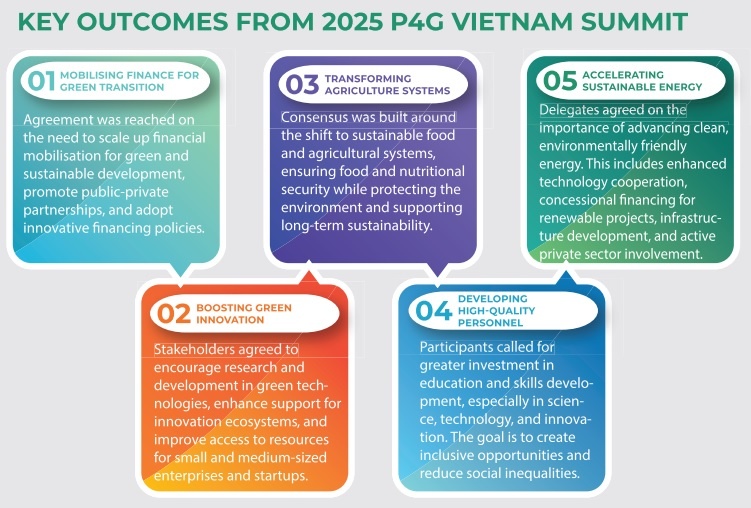 |
Dorado added that while multilateralism is being questioned or weakened in some quarters, the need for cooperation has never been more urgent – both to solve environmental challenges and to harness the transformative potential of innovation.
“No government or business can tackle these crises alone. Public authorities must provide the regulatory frameworks, fiscal incentives, and infrastructure deployment needed at scale to safeguard the common good,” he stressed.
From the business side, Stuart Livesey, country representative of Copenhagen Infrastructure Partners (CIP), provided a frank but optimistic outlook. Livesey stated CIP’s commitment to supporting Vietnam’s transition, but emphasised the need for enabling conditions.
“What we seek are clear, bankable projects underpinned by stable regulatory frameworks, collaborating with strong local partnerships. This is where public-private cooperation becomes not just helpful, but essential,” Livesey noted. “Over the next 10-15 years, the offshore wind sector and green energy consumers will trigger massive demand for new technologies, digital solutions, and skilled labour.”
To meet this demand, CIP is investing not only in infrastructure, but also in capacity building, research and development, and local supply chain development through partnerships with Vietnamese universities.
Still, he acknowledged barriers. “Technological application and innovation in green projects face challenges, from long-term financing constraints and skilled labour shortages to fragmented policy signals. These are not unique to Vietnam, but they require proactive, tailored local solutions,” he said. “Addressing issues such as grid availability, regulatory clarity, and inter-ministerial coordination will be critical.”
Tim Evans, CEO of HSBC Vietnam, stated that the banking sector is ready to facilitate green finance, particularly in sectors aligned with national climate targets.
“We see ourselves as a bridge between global capital and local sustainability goals. The clearer the pipeline of bankable, climate-aligned projects, the faster we can move capital,” he noted. “What’s crucial now is consistency in policy and coordination among stakeholders to ensure these projects reach maturity.”

Bac Giang International Logistics Centre launched

Vietnam’s Exclusive Economic Zone boasts over 1,000 GW of wind power potential: report

Uncertainty weighing on real estate

Central Vietnam city seeks $1.84 bln for 15 projects in economic zone

